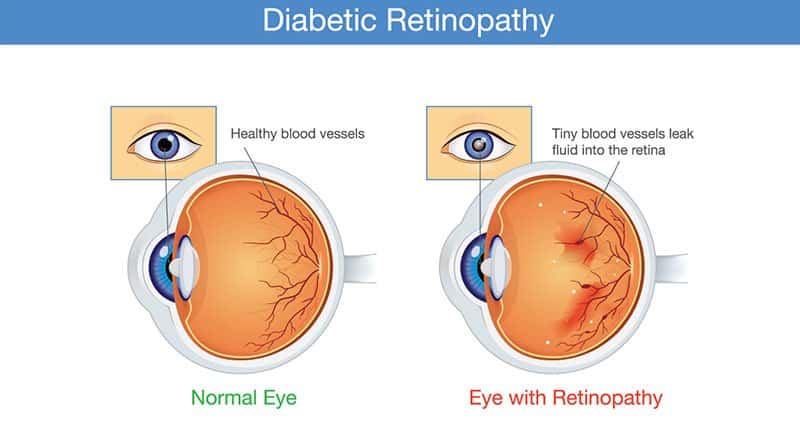
18 Nov 15 Facts About Diabetic Retinopathy
Diabetes is a disease that affects approximately 25 million American adults and children. For anyone diagnosed with diabetes, one very real concern is vision loss from the onset of diabetic retinopathy.
What is Diabetic Retinopathy?
So what is diabetic retinopathy? It’s a condition brought about by high blood sugar, the hallmark of uncontrolled diabetes. When blood sugar is high, it damages the tiny blood vessels that supply the retina, the light-sensitive tissue layer in the back of your eye. This in turn causes vision changes that—left untreated—can cause vision loss or even blindness.
Early Diabetic Retinopathy
The first signs of diabetic retinopathy are weak and bulging blood vessels in the retina. This is painless, and most people don’t notice any change in their vision until damage is already done.
As the tiny blood vessels leak, it causes vision changes as fluid builds up behind the lens of your eye and changes its shape enough that it can’t focus as it usually does. That’s the first stage of diabetic retinopathy.
Proliferative Diabetic Retinopathy
If you don’t get blood sugar levels under control, the disease will progress. As your body senses damage to the blood supply of the eye, it tries to counter the damage by growing new blood vessels. Unfortunately, these fragile new blood vessels are weak and prone to leaking. They leak fluid and blood into the back of your eye. That causes swelling, which results in clouded or blurry vision. This stage of the disease is called proliferative diabetic retinopathy.
Here are 15 facts about diabetic retinopathy:
- Everyone with diabetes is at risk for diabetic retinopathy. The longer you have diabetes, the more likely you are to develop diabetic retinopathy.
- If not treated, diabetic retinopathy can cause blindness. It’s one of the leading causes of blindness and vision loss, impacting more than 7.6 million people.
- In most patients, diabetic retinopathy affects both eyes at the same time.
- Of the 25 million adults and children living with diabetes in the US, approximately 75% of them will develop diabetic retinopathy within 10 years of their diagnosis.
- Diabetic retinopathy is not painful, and you may not notice symptoms until your vision has been damaged permanently. That’s why it’s critical for all diabetic patients to have a dilated comprehensive eye exam at least every 12 months.
- Optometrists diagnose more than 400,000 new cases of diabetes each year in patients who weren’t aware they had the condition. How? Diabetes causes changes to the blood vessels in the back of the eye that your optometrist can see during your annual dilated eye exam.
- When you experience long periods of high blood sugar, blood and other fluids accumulate behind the natural lens of your eye, causing it to swell and change shape, resulting in blurred vision. When you get your blood sugar back into target range, the swelling goes down, and vision often improves.
- Symptoms of diabetic retinopathy may include:
- Cloudy, blurred vision
- Changes to your central vision, including a dark spot or blind spot
- Floaters or floating spots
- Difficulty seeing well at night
- Sudden vision loss
- Diabetic retinopathy puts you at risk for a retinal detachment, which means the retina floats away from the back of the eye and loses blood flow. Retinal detachment is a medical emergency that must be treated immediately, or you risk serious and permanent vision loss or blindness.
- Smoking may increase your risk of developing diabetic retinopathy. If you stop smoking now, you may lower your risk for this sight-stealing disease.
- Patients who control blood glucose levels carefully can delay or prevent the onset of diabetic retinopathy and other diabetic-related eye diseases.
- The best treatment for diabetic retinopathy is prevention, achieved by closely controlling your blood sugar levels through proper medication, diet, exercise, not smoking, and avoiding alcohol.
- If you are diagnosed with diabetic retinopathy, in 90 percent of cases, your vision can be preserved with early detection and treatment.
- Treatment for diabetic retinopathy includes laser surgery and injectable medications, which reduce the growth of the weak, leaky blood vessels your body tries to grow.
- Whether you have diabetes or not, if you experience a sudden onset of extreme vision loss, such as a dark spot in your vision, or it seems like a curtain has closed over your visual field, seek emergency medical attention immediately. These are symptoms of a retinal detachment, which can cause permanent vision loss or blindness.
If you are diagnosed with diabetes, it’s critical to schedule a comprehensive eye exam at least every 12 months or more often if your optometrist advises it.
Call us today to make your appointment—it could put you on the path to preserving your vision for life!




Sorry, the comment form is closed at this time.